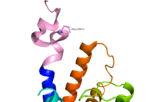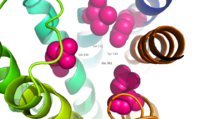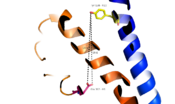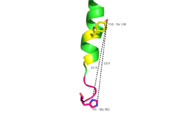Sandbox Reserved 1181
From Proteopedia
(Difference between revisions)
| Line 24: | Line 24: | ||
[[Image:Movie Frame 6.png |100 px|left|thumb|Fig. 10: Ballooned pocket functioning as anchoring site for glucagon residues 1-4.]] | [[Image:Movie Frame 6.png |100 px|left|thumb|Fig. 10: Ballooned pocket functioning as anchoring site for glucagon residues 1-4.]] | ||
| + | |||
| + | [[Image:Movie_Frame_7.png|175 px|left|thumb|Fig. 14: Distance measurement of GCGR 7TMD Y138-D362 of 19-20 angstroms and labeled with complimentary glucagon interaction residues.]] | ||
| + | [[Image:H1___Y10_with_measurement.png|175 px|right|thumb|Fig. 15: Distance measurement of H1-Y10 of 22-24 angstroms and labeled with complimentary GCGR 7TMD residue interactions.]] | ||
| + | |||
| + | ===Future research direction=== | ||
| + | Research for Class A GPCRs is much more extensive than for its secretin, class B counterparts, although class B is proving to be a worthwhile to invest researching. The challenge of class B stabilization, expression, and molecular size , has made class B GPCRs particularly hard to assay. Biochemical research has increased in the class B specifications, because it has been realized that receptors can be modulated by more than the agonist and antagonists present in vivo. Leading research consists of a complex interwoven scheme of equilibria manipulation in multi-receptor conformations. <ref name="Salon 2011"/> | ||
Revision as of 20:45, 20 April 2016
|
Old Stuff:

Fig. 1: A135P Mutation and effect on stalk stability [1].

Fig. 2: Stalk stabilized by salt bridge between Glu133-Lys136. Residues in yellow are demonstrated to have an effect on ligand binding affinity.[1]

Fig. 3: Active sites linked to glucagon binding affinity located on ECL1 are labeled[1].

Fig. 9: Location of anchoring pocket within central cavity.[1]
Future research direction
Research for Class A GPCRs is much more extensive than for its secretin, class B counterparts, although class B is proving to be a worthwhile to invest researching. The challenge of class B stabilization, expression, and molecular size , has made class B GPCRs particularly hard to assay. Biochemical research has increased in the class B specifications, because it has been realized that receptors can be modulated by more than the agonist and antagonists present in vivo. Leading research consists of a complex interwoven scheme of equilibria manipulation in multi-receptor conformations. [2]






